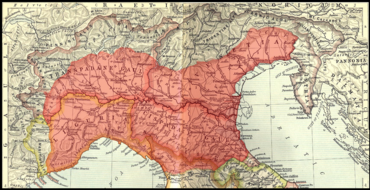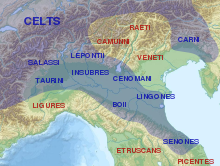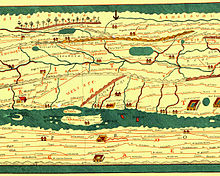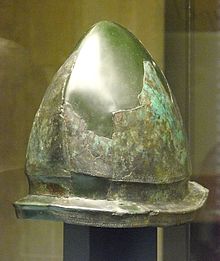
Cisalpine Gaul (Latin: Gallia Cisalpina, also called Gallia Citerior or Gallia Togata) was the name given, especially during the 4th and 3rd centuries BC, to a region of land inhabited by Celts (Gauls), corresponding to what is now most of northern Italy.
After its conquest by the Roman Republic in the 200s BC, it was considered geographically part of Roman Italy but remained administratively separated until 42 BC. It was a Roman province from c. 81 BC until 42 BC, when it was de jure merged into Roman Italy as already planned by Julius Caesar.
Cisalpine means "on this side of the Alps" (from the perspective of the Romans), as opposed to Transalpine Gaul ("on the far side of the Alps").
Gallia Cisalpina was further subdivided into Gallia Cispadana and Gallia Transpadana, i.e., its portions south and north of the Po River, respectively.
The Roman province of the 1st century BC was bounded on the north and west by the Alps, in the south as far as Placentia by the river Po, and then by the Apennines and the river Rubicon, and in the east by the Adriatic Sea.
In 49 BC, all inhabitants of Cisalpine Gaul received Roman citizenship, and eventually the province was divided among four of the eleven regions of Italy: Regio VIII Gallia Cispadana, Regio IX Liguria, Regio X Venetia et Histria, and Regio XI Gallia Transpadana.
History
Early history
Further information: Ancient peoples of Italy
The Canegrate culture (13th century BC) may represent the first migratory wave of the proto-Celtic population from the northwest part of the Alps that, through the Alpine passes, penetrated and settled in the western Po valley between Lake Maggiore and Lake Como (Scamozzina culture). They brought a new funerary practice—cremation—which supplanted inhumation. It has also been proposed that a more ancient proto-Celtic presence can be traced back to the beginning of the Middle Bronze Age (16th–15th century BC), when, regarding the production of bronze artefacts, including ornaments, North Western Italy appears to have been closely linked to the western groups of the Tumulus culture (Central Europe, 1600 BC – 1200 BC). The bearers of the Canegrate culture maintained its homogeneity for only a century, after which it melded with the Ligurian aboriginal populations and with this union gave rise to a new phase called the Golasecca culture, which is nowadays identified with the Celtic Lepontii. According to Livy (v. 34), the Bituriges, Arverni, Senones, Aedui, Ambarri, Carnutes, and Aulerci led by Bellovesus, arrived in northern Italy during the reign of Tarquinius Priscus (7th–6th century BC) and occupied the area between Milan and Cremona. Milan (Mediolanum) itself was presumably founded by Gauls in the early 6th century BC; its name has a Celtic etymology: " in the middle of the plain". Polybius, in the 2nd century BC, wrote that the Celts in northern Italy co-existed with Etruscan nations during a period before the Sack of Rome in 390 BC.
Ligures lived on the Northern Mediterranean Coast straddling southeast French and North-west Italian coasts, including parts of Tuscany, Elba island and Corsica. Ligurian tribes were also present in Latium (see Rutuli) and in Samnium. According to Plutarch they called themselves Ambrones, which suggests a possible relationship between them and the Ambrones of northern Europe. Little is known of the Ligurian language. Only place names and personal names remain. It appears to be an Indo-European language with both Italic and particularly strong Celtic affinities. Because of the strong Celtic influences on their language and culture, they were known in antiquity as Celto-Ligurians (in Greek Κελτολίγυες, Keltolígues). Modern linguists, like Xavier Delamarre, argue that Ligurian was a Celtic language with some similarity to Gaulish. The Ligurian-Celtic question is also discussed by Barruol (1999). Ancient Ligurian is listed either as Celtic (epigraphic) or Para-Celtic (onomastic).
The Veneti were Indo-European people who inhabited north-eastern Italy, in an area corresponding to the modern-day region of the Veneto, Friuli, and Trentino. By the 4th century BC the Veneti had been so Celticized that Polybius wrote that the Veneti of the 2nd century BC were identical to the Gauls except for their language. The Greek historian Strabo (64 BC–AD 24), on the other hand, conjectured that the Adriatic Veneti were descended from Celts, who in turn were related to a later Celtic tribe of the same name whose members lived on the Armorican coast and fought against Julius Caesar. He further suggested that the identification of the Adriatic Veneti with the Paphlagonian Enetoi led by Antenor — which he attributes to Sophocles (496–406 BC) — had been a mistake caused by the similarity of the names.
Gallic expansion and Roman conquest

In 391 BC, Celts "who had their homes beyond the Alps, streamed through the passes in great strength and seized the territory that lay between the Apennine mountains and the Alps" according to Diodorus Siculus. The Roman army was routed in the battle of Allia, and Rome was sacked in 390 BC by the Senones.
The defeat of the combined Samnite, Celtic and Etruscan alliance by the Romans in the Third Samnite War ending in 290 BC sounded the beginning of the end of the Celtic domination in mainland Europe. At the Battle of Telamon in 225 BC, a large Celtic army was trapped between two Roman forces and crushed.
In the Second Punic War, the Boii and Insubres allied themselves with the Carthaginians, laying siege to Mutina (Modena). In response, Rome sent an expedition led by L. Manlius Vulso. Vulso's army was ambushed twice, and the Senate sent Scipio with an additional force to provide support. These were the Roman forces encountered by Hannibal after he crossed the Alps. The Romans were defeated in the Battle of the Ticinus, leading all the Gauls except for the Cenomani to join the insurgency. Rome then sent the army of Tiberius Sempronius Longus who engaged Hannibal in the Battle of the Trebia, also resulting in a Roman defeat, forcing Rome to temporarily abandon Gallia Cisalpina altogether, returning only after the defeat of Carthage in 202 BC.
Publius Cornelius Scipio Nasica completed the conquest of the Boii in 191 BC, although the Ligurians were only finally subdued when the Apuani were defeated by Marcus Claudius Marcellus in 155 BC.
Roman province
See also: Roman Republican governors of GaulSometimes referred to as Gallia Citerior ("Hither Gaul"), Provincia Ariminum, or Gallia Togata ("Toga-wearing Gaul", indicating the region's early Romanization). Gallia Transpadana denoted that part of Cisalpine Gaul between the Padus (now the Po River) and the Alps, while Gallia Cispadana was the part to the south of the river.
Probably officially established around 81 BC, the province was governed from Mutina (modern-day Modena), where, in 73 BC, forces under Spartacus defeated the legion of Gaius Cassius Longinus, the provincial governor.
In 49 BC, with the Lex Roscia, Julius Caesar granted to the populations of the province full Roman citizenship.
The Rubicon River marked its southern boundary with Italia proper. By crossing this river in 49 BC with his loyal XIII Legion, returning from the conquest of Gaul, Julius Caesar precipitated the civil war within the Roman Republic which led, eventually, to the establishment of the Roman Empire. To this day the term "crossing the Rubicon" means, figuratively, "reaching the point of no return".
The province was merged into Italia about 42 BC, as part of Octavian's "Italicization" program during the Second Triumvirate. The dissolution of the provincia required a new governing law or lex, although its contemporary title is unknown. The parts of it inscribed on a bronze tablet preserved in the museum at Parma are entirely concerned with arranging the judiciary: the law appoints two viri and four viri juri dicundo and also mentions a Prefect of Mutina.
Virgil, Catullus and Livy, three famous sons of the province, were born in Gallia Cisalpina.
Archaeology


Canegrate culture
Main article: Canegrate cultureThe Canegrate culture reflects a late Bronze Age to early Iron Age culture in the Pianura Padana. These areas are now known as western Lombardy, eastern Piedmont and Canton Ticino.
The Canegrate culture testifies to the arrival of Urnfield migratory wave of populations from the northwest part of the Alps that, crossing the alpine passes, had infiltrated and settled in the western Po area between Lake Maggiore and the Lake of Como (see Scamozzina culture). They were bearers of a new funerary practice, which supplanted the old culture of inhumation and instead introduced cremation.
The population of Canegrate maintained its own homogeneity for a limited period, approximately a century, after which it blended with the Ligurian aboriginal populations to create the new Golasecca culture.
Golasecca culture
Main articles: Golasecca culture and Hallstatt cultureThe Culture of Golasecca (9th to 4th centuries BC) spread between the end of the Bronze Age and the beginning of the Iron Age in the areas of northwestern Lombardy and Piedmont, and the Canton Ticino. At the end of the prehistoric period, this was an area where travellers frequently stopped and had contact with the Hallstatt culture to the west, the Urnfield culture to the north and with the Villanova culture to the south. The Golasecca culture was initially concentrated in the foothills area south of the Alps. It later spread throughout the lakes area, and established many settlements representing this original culture. The oldest remains found thus far can be dated from the 9th century BC.
Language
Main articles: Cisalpine Gaulish and Lepontic languageThere is some debate whether the Lepontic language should be considered as a Gaulish dialect or an independent branch within Continental Celtic. Apart from Lepontic, the "Cisalpine Gaulish language" proper would be the Gaulish language as spoken by the Gauls invading northern Italy in the 4th century BC. This is a dialect of the larger Gaulish language, with some known phonetic features distinguishing it from Transalpine dialects, such as -nn- replacing -nd- and s(s) replacing -χs-.
See also
- Northern Italy
- Canegrate culture
- Golasecca culture
- Cisalpine Gaulish
- Etruscans
- Iron Age Italy
- Ancient peoples of Italy
- Transalpine Gaul
References
- The Historical Atlas by William R. Shepherd, 1911 edition
- von Hefner, Joseph (1837). Geographie des Transalpinischen Galliens. Munich.
- Umberto Moscatelli (2010). "University of Macerata. I Romani in montagna: tra immaginario e razionalità".
- Williams, J. H. C. (2001). Beyond the Rubicon: Romans and Gauls in Republican Italy. Oxford University Press. ISBN 978-0-19-815300-9. Archived from the original on 2020-05-22.
- Long, George (1866). Decline of the Roman republic: Volume 2. London.
{{cite book}}: CS1 maint: location missing publisher (link) - Snith, William George (1854). Dictionary of Greek and Roman geography: Vol.1. Boston.
{{cite book}}: CS1 maint: location missing publisher (link) - Schmitz, Leonhard (1857). A manual of ancient geography. Philadelphia: Blanchard and Lea.
- Cassius Dio XLI, 36.
- Brouwer, Hendrik H. J. (1989). Hiera Kala: Images of animal sacrifice in archaic and classical Greece. Utrecht.
{{cite book}}: CS1 maint: location missing publisher (link) - Venceslas Kruta: La grande storia dei celti. La nascita, l'affermazione e la decadenza, Newton & Compton, 2003, ISBN 88-8289-851-2, ISBN 978-88-8289-851-9
- Maps of the Golasecca culture. "Archived copy". Archived from the original on 2011-07-22. Retrieved 2010-08-10.
{{cite web}}: CS1 maint: archived copy as title (link) - G. Frigerio, Il territorio comasco dall'età della pietra alla fine dell'età del bronzo, in Como nell'antichità, Società Archeologica Comense, Como 1987.
- Kruta, Venceslas (1991). The Celts. Thames & Hudson. pp. 52–56.
- Stifter, David (2008). Old Celtic Languages (PDF). pp. 24–37.
- Hazlitt, William. The Classical Gazetteer (1851), p. 297.
- Polo, Francisco Pina. "Deportation of Indigenous Population as a Strategy for Roman Dominion in Hispania". Limes Xx Gladius, Anejos 13, 2009.
- Boardman, John (1988). The Cambridge ancient history: Persia, Greece and the Western Mediterranean c. 525-479 BC. p. 716.
- Baldi, Philip (2002). The Foundations of Latin. Walter de Gruyter. p. 112.
- Delamarre, Xavier (2003). Dictionnaire de la langue gauloise : une approche linguistique du vieux-celtique continental (2e ed.). Paris: Errance. ISBN 9782877722377.
- Kruta, Venceslas (1991). The Celts. Thames and Hudson. p. 54.
- Kruta, Venceslas (1991). The Celts. Thames and Hudson. p. 55.
- Storia, vita, costumi, religiosità dei Veneti antichi at .www.venetoimage.com (in Italian). Accessed on 2009-08-18.
- History of the Roman World: 753 to 146 BC by H. H. Scullard,2002, page 16: "... of healing. In the fourth century, their culture became so Celticized that Polybius described the second-century Veneti as practically in- distinguishable ..."
- Strabo, Geography, Book IV, Chapter 4: "It is these Veneti , I think, who settled the colony that is on the Adriatic (for about all the Celti that are in Italy migrated from the transalpine land, just as did the Boii and Senones), although, on account of the likeness of name, people call them Paphlagonians. I do not speak positively, however, for with reference to such matters probability suffices." Book V, Chapter 1: "Concerning the Heneti there are two different accounts: Some say that the Heneti too are colonists of those Celti of like name who live on the ocean-coast; while others say that certain of the Heneti of Paphlagonia escaped hither with Antenor from the Trojan war, and, as testimony in this, adduce their devotion to the breeding of horses — a devotion which now, indeed, has wholly disappeared, although formerly it was prized among them, from the fact of their ancient rivalry in the matter of producing mares for mule-breeding." Book 13, Chapter 1: "At any rate, Sophocles says that Antenor and his children safely escaped to Thrace with the survivors of the Heneti, and from there got across to the Adriatic Henetice, as it is called."
- "CLADES GALLICA - SACCO DI ROMA (390 a.c.)" (in Italian). Retrieved 5 July 2023.
- "BATTAGLIA DI TALAMONE (225 a.c.)" (in Italian). Retrieved 5 July 2023.
- "L'ombra di Annibale. Amilcare e l'insurrezione della Gallia Cisalpina (200-197 a.C.)" (in Italian). 31 March 2022. Retrieved 5 July 2023.
- Livy, 36.38
- Fasti Triumphales, Attalus.
- Chrystal, Paul (2019). "How did it come to this". Rome : Republic into Empire : the civil wars of the first century BCE. Barnsley, South Yorkshire: Pen and Sword. ISBN 9781526710093.
- Uchicago.edu
- The Dawn of the Roman Empire, by Livy, John Yardley, Waldemar Heckel.
- Kruta, Venceslas: La grande storia dei celti. La nascita, l'affermazione e la decadenza, Newton & Compton, 2003, ISBN 88-8289-851-2, ISBN 978-88-8289-851-9
Further reading
- Arslan E. A. 1992 (1995), La Nécropole celtique de Garlasco (Province de Pavie), in L’Europe celtique du Ve au IIIe Siècle avant J.-C. (Hautvillers, 8-10 octobre 1992), Sceaux, pp. 169–188.
- Luigi Bossi, Della istoria d'Italia antica e moderna, Milano, 1819
- Jean Bousquet, La Cisalpine gauloise du IIIe au Ier siècle avant J.-C.
- Corbella, Roberto: "Celti : itinerari storici e turistici tra Lombardia, Piemonte, Svizzera", Macchione, Varese c2000; 119 p., ill.; 20 cm; ISBN 9788883400308
- Corbella, Roberto: "Magia e mistero nella terra dei Celti : Como, Varesotto, Ossola"; Macchione, Varese 2004; 159 p. : ill. ; 25 cm; ISBN 9788883401862
- D'Aversa, Arnaldo: "La Valle Padana tra Etruschi, Celti e Romani", PAIDEIA, Brescia 1986, 101 p. ill., 21 cm, ISBN 88-394-0381-7
- Raffaele De Marinis and Venceslas Kruta in ‘’Italia, omnium terrarum alumna’’, Garzanti-Scheiwiller, 1990
- Grassi, Maria Teresa: "I Celti in Italia" - 2. ed, Longanesi, Milano 1991 (Biblioteca di Archelogia); 154 p., 32 c. di tav., ill. ; 21 cm; ISBN 88-304-1012-8
- Grassi, Maria Teresa: "La ceramica a vernice nera di Calvatone-Bedriacum", All'Insegna del Giglio, Firenze 2008, pp. 224 brossura, ISSN/ISBN 9788878143692
- Grassi M. T. 1995, La romanizzazione degli Insubri. Celti e Romani in Transpadana attraverso la documentazione storica e archeologica, Milano.
- Grassi M. T. 1999, I Celti della Cisalpina Centrale: dall’ager Insubrium alla XI Regio Transpadana, in Insubri e Cenomani tra Sesia e Adige, Seminario di Studi (Milano 27-28.2.1998), “Rassegna di Studi del Civico Museo Archeologico e del Civico Gabinetto Numismatico di Milano”, LXIII-LXIV, pp. 101–108.
- Lawrence Keppie, The Making of the Roman Army, From Republic to Empire, University of Oklahoma, 1998
- Kruta, Venceslas: "I celti e il Mediterraneo", Jaca Book, 2004, 78 p., ISBN 88-16-43628-X, ISBN 978-88-16-43628-2
- Kruta, Venceslas: "La grande storia dei celti. La nascita, l'affermazione e la decadenza", Newton & Compton, 2003, 512 p., ISBN 88-8289-851-2, ISBN 978-88-8289-851-9
- Kruta, Venceslas & Manfredi, Valerio M.: "I celti d'Italia", Mondadori, 2000 (Collana: Oscar storia), ISBN 88-04-47710-5, ISBN 978-88-04-47710-5
- Giuseppe Micali, L'Italia avanti il dominio dei Romani, Genova, 1830
- Smith, William, ed. (1854). "Gallia Cisalpina". Dictionary of Greek and Roman Geography. London: Walton and Maberly.
- Violante, Antonio; introduzione di Venceslas Kruta: "I Celti a sud delle Alpi", Silvana, Milano 1993 (Popoli dell'Italia Antica), 137 p., ill., fot.; 32 cm; ISBN 88-366-0442-0
| Celts and modern Celts | |||||||||||||||||||||||
|---|---|---|---|---|---|---|---|---|---|---|---|---|---|---|---|---|---|---|---|---|---|---|---|
| Celtic nations · Celtic studies · Celtic tribes · Celtic languages | |||||||||||||||||||||||
|  | ||||||||||||||||||||||
| |||||||||||||||||||||||
| |||||||||||||||||||||||
| |||||||||||||||||||||||
| |||||||||||||||||||||||
| |||||||||||||||||||||||
| |||||||||||||||||||||||
| |||||||||||||||||||||||
| Italy articles | |||||||||||||||||
|---|---|---|---|---|---|---|---|---|---|---|---|---|---|---|---|---|---|
| History |
| ||||||||||||||||
| Geography | |||||||||||||||||
| Politics | |||||||||||||||||
| Economy | |||||||||||||||||
| Society |
| ||||||||||||||||
Categories: